NURS2201: Cochrane Review on Cardiovascular Diseases, Semester 2, 2018
VerifiedAdded on 2023/06/08
|6
|1591
|450
Report
AI Summary
This report is a student's analysis of a Cochrane review focusing on cardiovascular and chronic respiratory diseases. It addresses the NMBA Registered Nurse Standards, the background and objectives of the review, the methods employed, and the results obtained. The student discusses the implications of the findings for nursing practice, emphasizing the importance of interventions and the need for further research. The report also includes APA referencing and a justification of the assignment's adherence to the requirements.
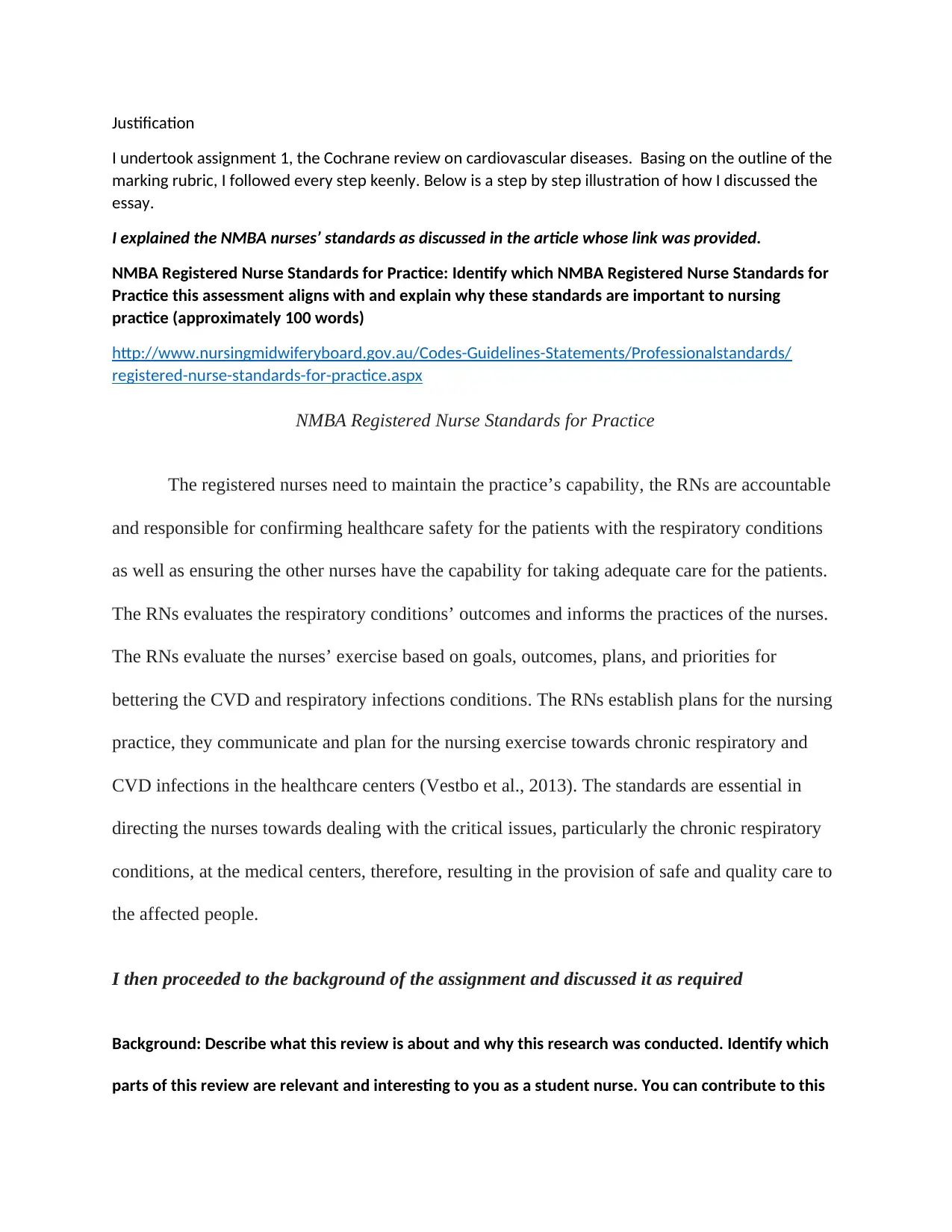
Justification
I undertook assignment 1, the Cochrane review on cardiovascular diseases. Basing on the outline of the
marking rubric, I followed every step keenly. Below is a step by step illustration of how I discussed the
essay.
I explained the NMBA nurses’ standards as discussed in the article whose link was provided.
NMBA Registered Nurse Standards for Practice: Identify which NMBA Registered Nurse Standards for
Practice this assessment aligns with and explain why these standards are important to nursing
practice (approximately 100 words)
http://www.nursingmidwiferyboard.gov.au/Codes-Guidelines-Statements/Professionalstandards/
registered-nurse-standards-for-practice.aspx
NMBA Registered Nurse Standards for Practice
The registered nurses need to maintain the practice’s capability, the RNs are accountable
and responsible for confirming healthcare safety for the patients with the respiratory conditions
as well as ensuring the other nurses have the capability for taking adequate care for the patients.
The RNs evaluates the respiratory conditions’ outcomes and informs the practices of the nurses.
The RNs evaluate the nurses’ exercise based on goals, outcomes, plans, and priorities for
bettering the CVD and respiratory infections conditions. The RNs establish plans for the nursing
practice, they communicate and plan for the nursing exercise towards chronic respiratory and
CVD infections in the healthcare centers (Vestbo et al., 2013). The standards are essential in
directing the nurses towards dealing with the critical issues, particularly the chronic respiratory
conditions, at the medical centers, therefore, resulting in the provision of safe and quality care to
the affected people.
I then proceeded to the background of the assignment and discussed it as required
Background: Describe what this review is about and why this research was conducted. Identify which
parts of this review are relevant and interesting to you as a student nurse. You can contribute to this
I undertook assignment 1, the Cochrane review on cardiovascular diseases. Basing on the outline of the
marking rubric, I followed every step keenly. Below is a step by step illustration of how I discussed the
essay.
I explained the NMBA nurses’ standards as discussed in the article whose link was provided.
NMBA Registered Nurse Standards for Practice: Identify which NMBA Registered Nurse Standards for
Practice this assessment aligns with and explain why these standards are important to nursing
practice (approximately 100 words)
http://www.nursingmidwiferyboard.gov.au/Codes-Guidelines-Statements/Professionalstandards/
registered-nurse-standards-for-practice.aspx
NMBA Registered Nurse Standards for Practice
The registered nurses need to maintain the practice’s capability, the RNs are accountable
and responsible for confirming healthcare safety for the patients with the respiratory conditions
as well as ensuring the other nurses have the capability for taking adequate care for the patients.
The RNs evaluates the respiratory conditions’ outcomes and informs the practices of the nurses.
The RNs evaluate the nurses’ exercise based on goals, outcomes, plans, and priorities for
bettering the CVD and respiratory infections conditions. The RNs establish plans for the nursing
practice, they communicate and plan for the nursing exercise towards chronic respiratory and
CVD infections in the healthcare centers (Vestbo et al., 2013). The standards are essential in
directing the nurses towards dealing with the critical issues, particularly the chronic respiratory
conditions, at the medical centers, therefore, resulting in the provision of safe and quality care to
the affected people.
I then proceeded to the background of the assignment and discussed it as required
Background: Describe what this review is about and why this research was conducted. Identify which
parts of this review are relevant and interesting to you as a student nurse. You can contribute to this
Paraphrase This Document
Need a fresh take? Get an instant paraphrase of this document with our AI Paraphraser
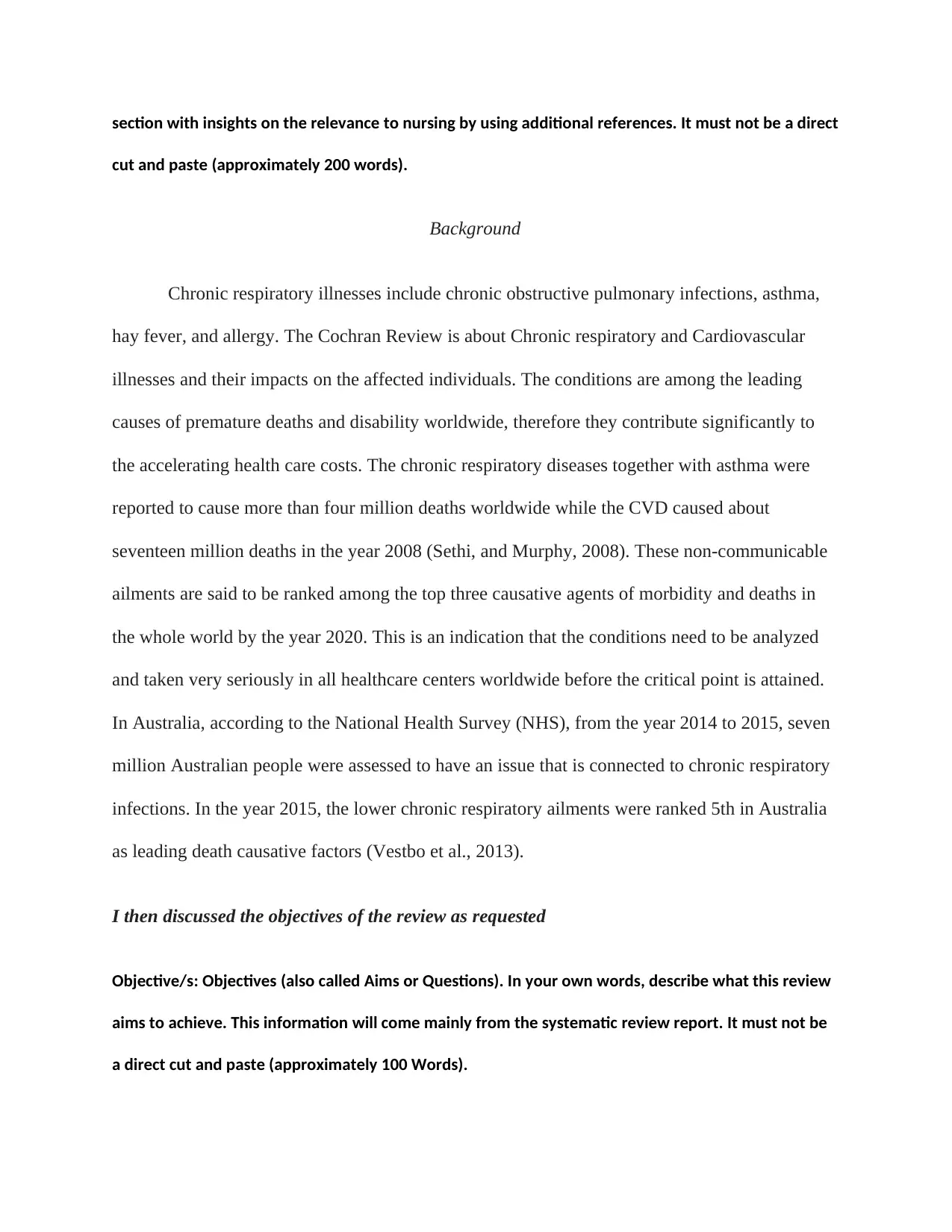
section with insights on the relevance to nursing by using additional references. It must not be a direct
cut and paste (approximately 200 words).
Background
Chronic respiratory illnesses include chronic obstructive pulmonary infections, asthma,
hay fever, and allergy. The Cochran Review is about Chronic respiratory and Cardiovascular
illnesses and their impacts on the affected individuals. The conditions are among the leading
causes of premature deaths and disability worldwide, therefore they contribute significantly to
the accelerating health care costs. The chronic respiratory diseases together with asthma were
reported to cause more than four million deaths worldwide while the CVD caused about
seventeen million deaths in the year 2008 (Sethi, and Murphy, 2008). These non-communicable
ailments are said to be ranked among the top three causative agents of morbidity and deaths in
the whole world by the year 2020. This is an indication that the conditions need to be analyzed
and taken very seriously in all healthcare centers worldwide before the critical point is attained.
In Australia, according to the National Health Survey (NHS), from the year 2014 to 2015, seven
million Australian people were assessed to have an issue that is connected to chronic respiratory
infections. In the year 2015, the lower chronic respiratory ailments were ranked 5th in Australia
as leading death causative factors (Vestbo et al., 2013).
I then discussed the objectives of the review as requested
Objective/s: Objectives (also called Aims or Questions). In your own words, describe what this review
aims to achieve. This information will come mainly from the systematic review report. It must not be
a direct cut and paste (approximately 100 Words).
cut and paste (approximately 200 words).
Background
Chronic respiratory illnesses include chronic obstructive pulmonary infections, asthma,
hay fever, and allergy. The Cochran Review is about Chronic respiratory and Cardiovascular
illnesses and their impacts on the affected individuals. The conditions are among the leading
causes of premature deaths and disability worldwide, therefore they contribute significantly to
the accelerating health care costs. The chronic respiratory diseases together with asthma were
reported to cause more than four million deaths worldwide while the CVD caused about
seventeen million deaths in the year 2008 (Sethi, and Murphy, 2008). These non-communicable
ailments are said to be ranked among the top three causative agents of morbidity and deaths in
the whole world by the year 2020. This is an indication that the conditions need to be analyzed
and taken very seriously in all healthcare centers worldwide before the critical point is attained.
In Australia, according to the National Health Survey (NHS), from the year 2014 to 2015, seven
million Australian people were assessed to have an issue that is connected to chronic respiratory
infections. In the year 2015, the lower chronic respiratory ailments were ranked 5th in Australia
as leading death causative factors (Vestbo et al., 2013).
I then discussed the objectives of the review as requested
Objective/s: Objectives (also called Aims or Questions). In your own words, describe what this review
aims to achieve. This information will come mainly from the systematic review report. It must not be
a direct cut and paste (approximately 100 Words).
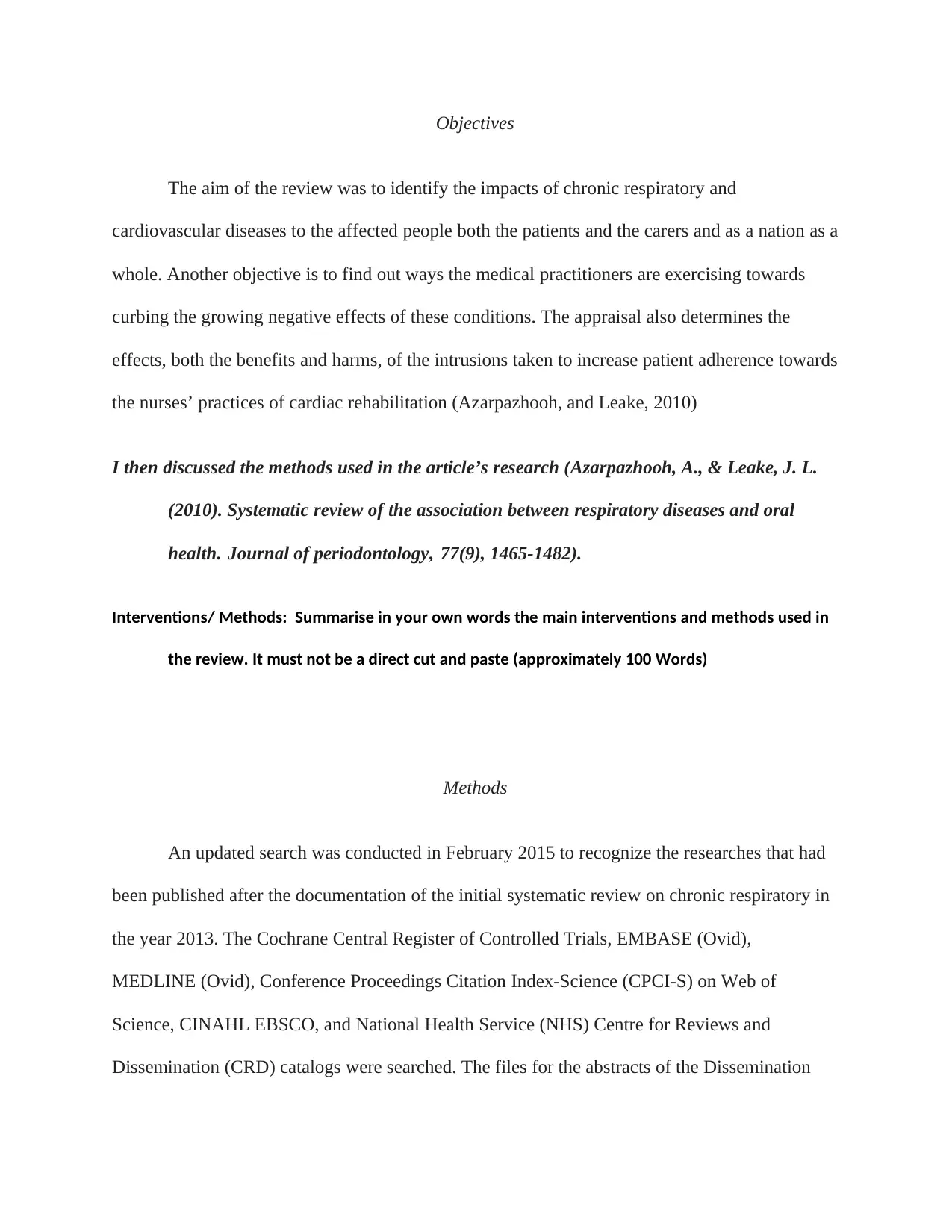
Objectives
The aim of the review was to identify the impacts of chronic respiratory and
cardiovascular diseases to the affected people both the patients and the carers and as a nation as a
whole. Another objective is to find out ways the medical practitioners are exercising towards
curbing the growing negative effects of these conditions. The appraisal also determines the
effects, both the benefits and harms, of the intrusions taken to increase patient adherence towards
the nurses’ practices of cardiac rehabilitation (Azarpazhooh, and Leake, 2010)
I then discussed the methods used in the article’s research (Azarpazhooh, A., & Leake, J. L.
(2010). Systematic review of the association between respiratory diseases and oral
health. Journal of periodontology, 77(9), 1465-1482).
Interventions/ Methods: Summarise in your own words the main interventions and methods used in
the review. It must not be a direct cut and paste (approximately 100 Words)
Methods
An updated search was conducted in February 2015 to recognize the researches that had
been published after the documentation of the initial systematic review on chronic respiratory in
the year 2013. The Cochrane Central Register of Controlled Trials, EMBASE (Ovid),
MEDLINE (Ovid), Conference Proceedings Citation Index-Science (CPCI-S) on Web of
Science, CINAHL EBSCO, and National Health Service (NHS) Centre for Reviews and
Dissemination (CRD) catalogs were searched. The files for the abstracts of the Dissemination
The aim of the review was to identify the impacts of chronic respiratory and
cardiovascular diseases to the affected people both the patients and the carers and as a nation as a
whole. Another objective is to find out ways the medical practitioners are exercising towards
curbing the growing negative effects of these conditions. The appraisal also determines the
effects, both the benefits and harms, of the intrusions taken to increase patient adherence towards
the nurses’ practices of cardiac rehabilitation (Azarpazhooh, and Leake, 2010)
I then discussed the methods used in the article’s research (Azarpazhooh, A., & Leake, J. L.
(2010). Systematic review of the association between respiratory diseases and oral
health. Journal of periodontology, 77(9), 1465-1482).
Interventions/ Methods: Summarise in your own words the main interventions and methods used in
the review. It must not be a direct cut and paste (approximately 100 Words)
Methods
An updated search was conducted in February 2015 to recognize the researches that had
been published after the documentation of the initial systematic review on chronic respiratory in
the year 2013. The Cochrane Central Register of Controlled Trials, EMBASE (Ovid),
MEDLINE (Ovid), Conference Proceedings Citation Index-Science (CPCI-S) on Web of
Science, CINAHL EBSCO, and National Health Service (NHS) Centre for Reviews and
Dissemination (CRD) catalogs were searched. The files for the abstracts of the Dissemination
⊘ This is a preview!⊘
Do you want full access?
Subscribe today to unlock all pages.

Trusted by 1+ million students worldwide
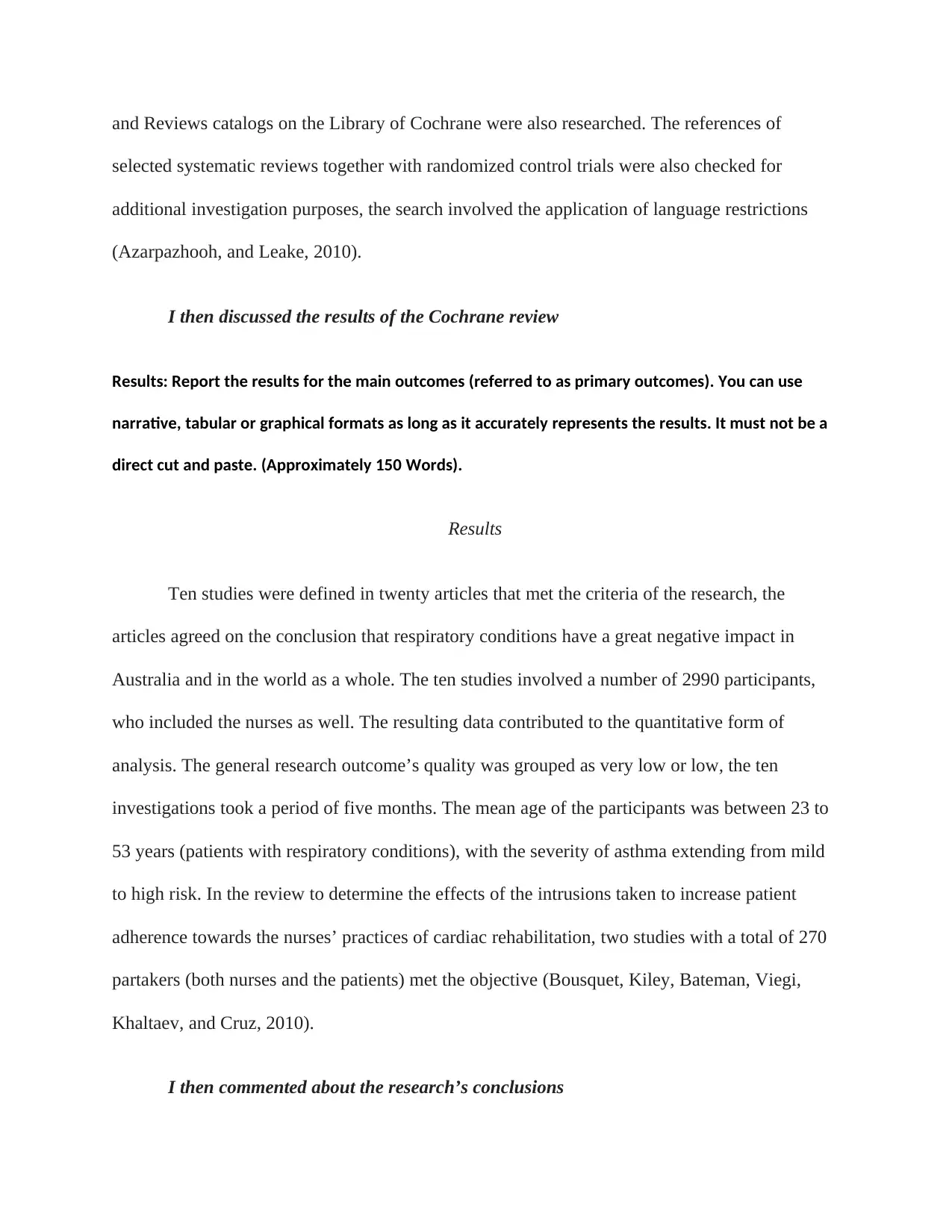
and Reviews catalogs on the Library of Cochrane were also researched. The references of
selected systematic reviews together with randomized control trials were also checked for
additional investigation purposes, the search involved the application of language restrictions
(Azarpazhooh, and Leake, 2010).
I then discussed the results of the Cochrane review
Results: Report the results for the main outcomes (referred to as primary outcomes). You can use
narrative, tabular or graphical formats as long as it accurately represents the results. It must not be a
direct cut and paste. (Approximately 150 Words).
Results
Ten studies were defined in twenty articles that met the criteria of the research, the
articles agreed on the conclusion that respiratory conditions have a great negative impact in
Australia and in the world as a whole. The ten studies involved a number of 2990 participants,
who included the nurses as well. The resulting data contributed to the quantitative form of
analysis. The general research outcome’s quality was grouped as very low or low, the ten
investigations took a period of five months. The mean age of the participants was between 23 to
53 years (patients with respiratory conditions), with the severity of asthma extending from mild
to high risk. In the review to determine the effects of the intrusions taken to increase patient
adherence towards the nurses’ practices of cardiac rehabilitation, two studies with a total of 270
partakers (both nurses and the patients) met the objective (Bousquet, Kiley, Bateman, Viegi,
Khaltaev, and Cruz, 2010).
I then commented about the research’s conclusions
selected systematic reviews together with randomized control trials were also checked for
additional investigation purposes, the search involved the application of language restrictions
(Azarpazhooh, and Leake, 2010).
I then discussed the results of the Cochrane review
Results: Report the results for the main outcomes (referred to as primary outcomes). You can use
narrative, tabular or graphical formats as long as it accurately represents the results. It must not be a
direct cut and paste. (Approximately 150 Words).
Results
Ten studies were defined in twenty articles that met the criteria of the research, the
articles agreed on the conclusion that respiratory conditions have a great negative impact in
Australia and in the world as a whole. The ten studies involved a number of 2990 participants,
who included the nurses as well. The resulting data contributed to the quantitative form of
analysis. The general research outcome’s quality was grouped as very low or low, the ten
investigations took a period of five months. The mean age of the participants was between 23 to
53 years (patients with respiratory conditions), with the severity of asthma extending from mild
to high risk. In the review to determine the effects of the intrusions taken to increase patient
adherence towards the nurses’ practices of cardiac rehabilitation, two studies with a total of 270
partakers (both nurses and the patients) met the objective (Bousquet, Kiley, Bateman, Viegi,
Khaltaev, and Cruz, 2010).
I then commented about the research’s conclusions
Paraphrase This Document
Need a fresh take? Get an instant paraphrase of this document with our AI Paraphraser
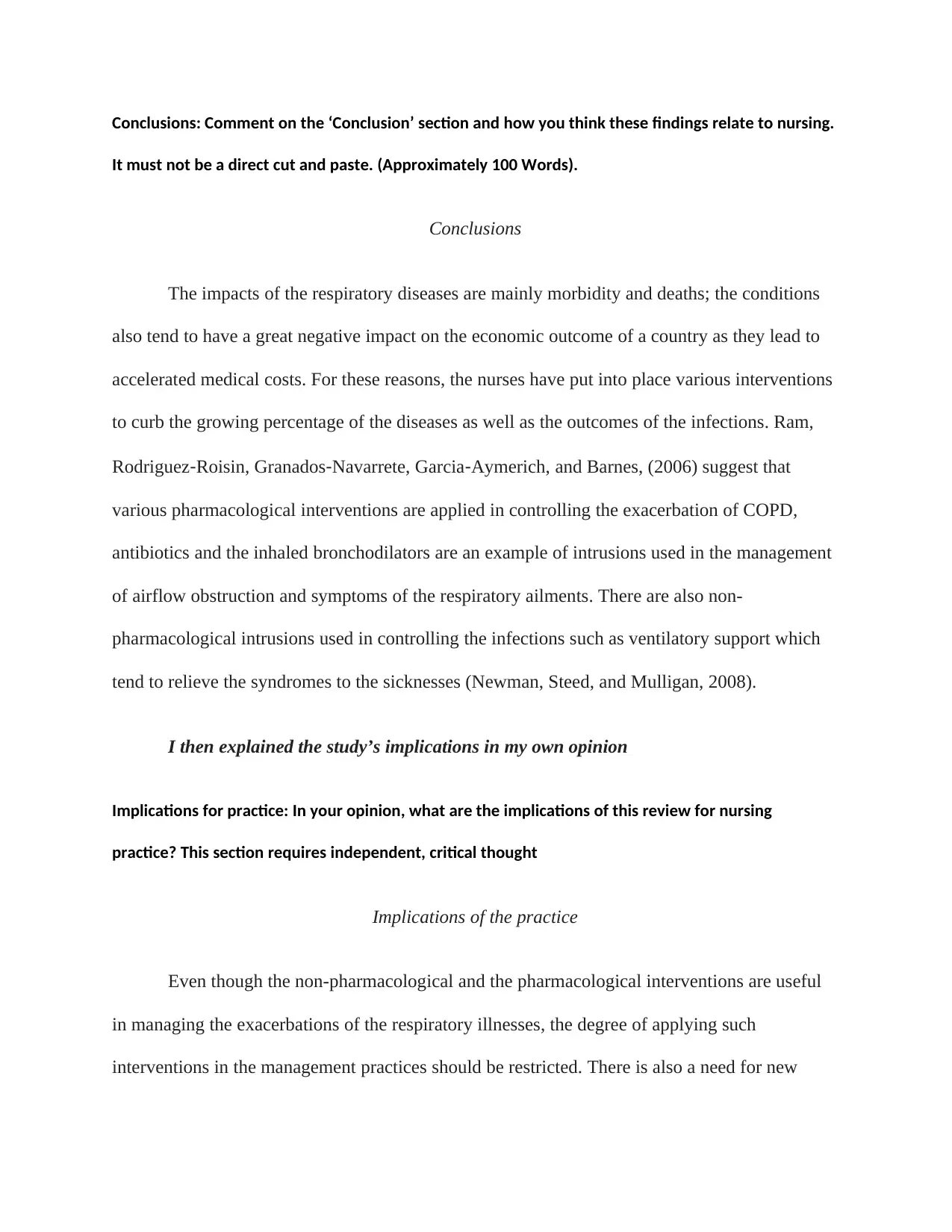
Conclusions: Comment on the ‘Conclusion’ section and how you think these findings relate to nursing.
It must not be a direct cut and paste. (Approximately 100 Words).
Conclusions
The impacts of the respiratory diseases are mainly morbidity and deaths; the conditions
also tend to have a great negative impact on the economic outcome of a country as they lead to
accelerated medical costs. For these reasons, the nurses have put into place various interventions
to curb the growing percentage of the diseases as well as the outcomes of the infections. Ram,
Rodriguez‐Roisin, Granados‐Navarrete, Garcia‐Aymerich, and Barnes, (2006) suggest that
various pharmacological interventions are applied in controlling the exacerbation of COPD,
antibiotics and the inhaled bronchodilators are an example of intrusions used in the management
of airflow obstruction and symptoms of the respiratory ailments. There are also non-
pharmacological intrusions used in controlling the infections such as ventilatory support which
tend to relieve the syndromes to the sicknesses (Newman, Steed, and Mulligan, 2008).
I then explained the study’s implications in my own opinion
Implications for practice: In your opinion, what are the implications of this review for nursing
practice? This section requires independent, critical thought
Implications of the practice
Even though the non-pharmacological and the pharmacological interventions are useful
in managing the exacerbations of the respiratory illnesses, the degree of applying such
interventions in the management practices should be restricted. There is also a need for new
It must not be a direct cut and paste. (Approximately 100 Words).
Conclusions
The impacts of the respiratory diseases are mainly morbidity and deaths; the conditions
also tend to have a great negative impact on the economic outcome of a country as they lead to
accelerated medical costs. For these reasons, the nurses have put into place various interventions
to curb the growing percentage of the diseases as well as the outcomes of the infections. Ram,
Rodriguez‐Roisin, Granados‐Navarrete, Garcia‐Aymerich, and Barnes, (2006) suggest that
various pharmacological interventions are applied in controlling the exacerbation of COPD,
antibiotics and the inhaled bronchodilators are an example of intrusions used in the management
of airflow obstruction and symptoms of the respiratory ailments. There are also non-
pharmacological intrusions used in controlling the infections such as ventilatory support which
tend to relieve the syndromes to the sicknesses (Newman, Steed, and Mulligan, 2008).
I then explained the study’s implications in my own opinion
Implications for practice: In your opinion, what are the implications of this review for nursing
practice? This section requires independent, critical thought
Implications of the practice
Even though the non-pharmacological and the pharmacological interventions are useful
in managing the exacerbations of the respiratory illnesses, the degree of applying such
interventions in the management practices should be restricted. There is also a need for new
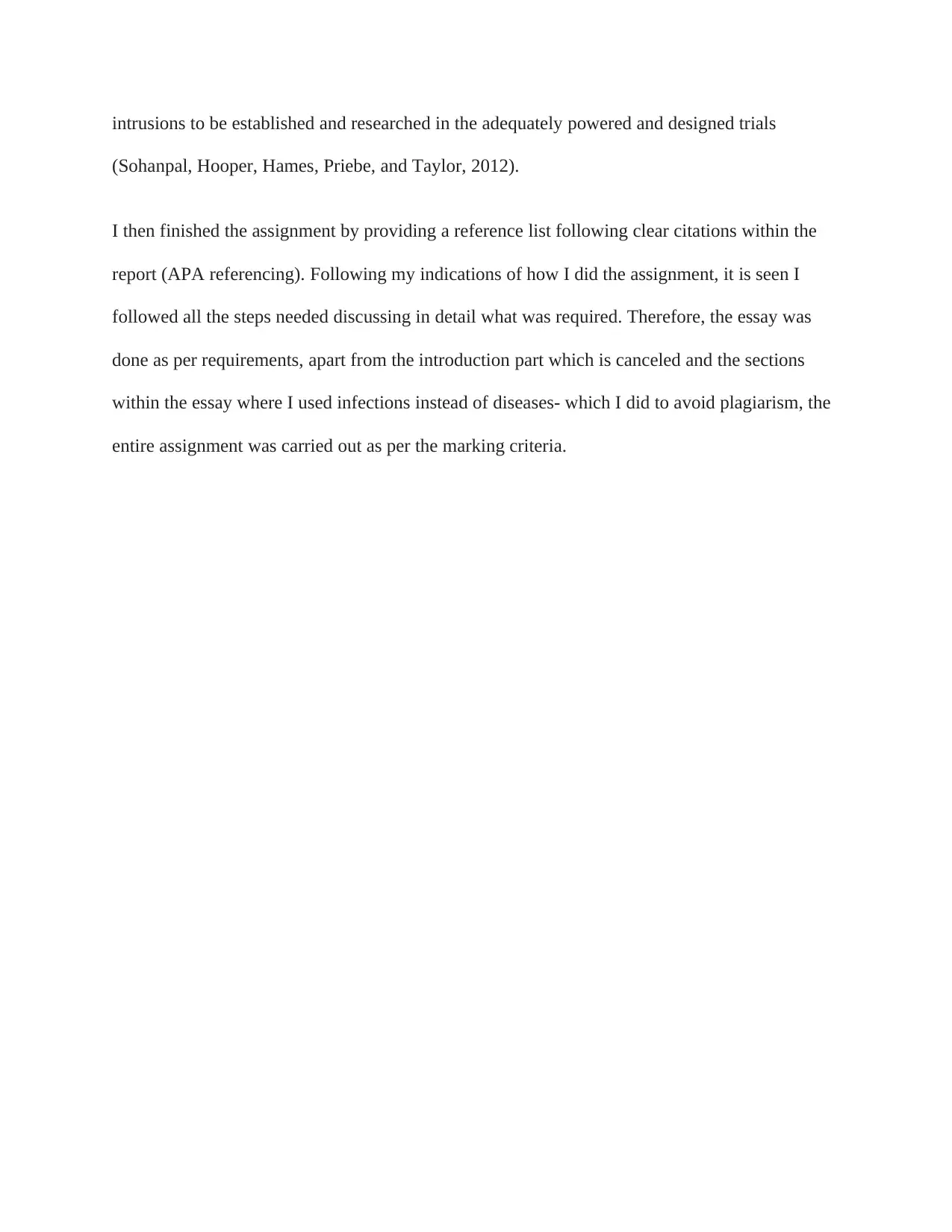
intrusions to be established and researched in the adequately powered and designed trials
(Sohanpal, Hooper, Hames, Priebe, and Taylor, 2012).
I then finished the assignment by providing a reference list following clear citations within the
report (APA referencing). Following my indications of how I did the assignment, it is seen I
followed all the steps needed discussing in detail what was required. Therefore, the essay was
done as per requirements, apart from the introduction part which is canceled and the sections
within the essay where I used infections instead of diseases- which I did to avoid plagiarism, the
entire assignment was carried out as per the marking criteria.
(Sohanpal, Hooper, Hames, Priebe, and Taylor, 2012).
I then finished the assignment by providing a reference list following clear citations within the
report (APA referencing). Following my indications of how I did the assignment, it is seen I
followed all the steps needed discussing in detail what was required. Therefore, the essay was
done as per requirements, apart from the introduction part which is canceled and the sections
within the essay where I used infections instead of diseases- which I did to avoid plagiarism, the
entire assignment was carried out as per the marking criteria.
⊘ This is a preview!⊘
Do you want full access?
Subscribe today to unlock all pages.

Trusted by 1+ million students worldwide
1 out of 6
Your All-in-One AI-Powered Toolkit for Academic Success.
+13062052269
info@desklib.com
Available 24*7 on WhatsApp / Email
![[object Object]](/_next/static/media/star-bottom.7253800d.svg)
Unlock your academic potential
Copyright © 2020–2025 A2Z Services. All Rights Reserved. Developed and managed by ZUCOL.

